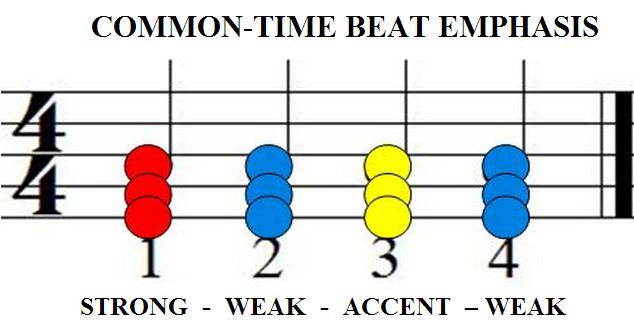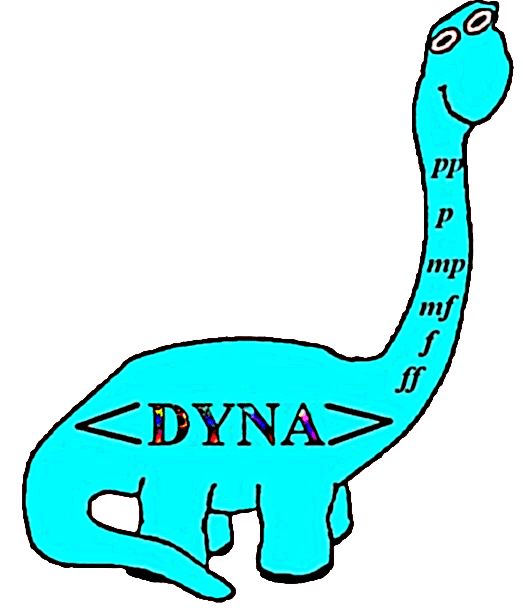DYNAMIC MARCH
Hello again, everyone!
As DYNA, I enjoy music that features dynamic contrast.
In an orchestra, many rhythms and instrument sounds combine, creating the complete texture.
Conductors are very much like recording studio engineers, in the sense that they balance dynamic ranges of the orchestra live.
In Dynamic March, each section has the opportunity to perform the melody as the primary theme, and also act as the accompaniment, the background.
One can view the orchestra as a string band, where the vocals are sung by different string instruments, while others perform back-up roles, like rhythm guitar, bass or drums.
Composers make use of dynamics in order to highlight melody.

March tempo is most commonly performed at 120 BPM, which is the equivalent to 1-beat every half-second.
Remember Beat Emphasis?
In March-Time, you perform with strong emphasis on the 1st beat of each measure.
A secondary accent is performed on the 3rd of the measure.
The goal of Dynamic March is to train players to perform melody and accompaniment, brought to action dynamically, in harmony.


D Major Home Instrument Tapes Finger Mechanics Finger Numbering Finger Dexterity Finger Position
Finger Intensity Hand Position Principles Hand Position Rhymes Space at the Base Swell the Well Swing the Wing
Hand Position Set-Up Violin Notes on D Viola Notes on D Cello Notes on D Bass Notes on D Violin Notes on A
Viola Notes on A Cello Notes on A Meet Guide Bass Notes on G D Major Training Exercises The Lower-Tetrachord
The Major Second The Major Third The Perfect Fourth The Upper-Tetrachord The Perfect Fifth The Major Sixth
The Major Seventh The Perfect Octave The Complete D Major Scale Left Thumb Logic Left Thumb Flexible Location
Knuckle Leverage D Major Etudes Arpeggio Patterns D Major Mastery Checkpoint Extending the Instrument’s Range
Finger Location Terms Violin Notes on G Viola Notes on G Cello Notes on G Bass Notes on E Bass Notes on A
Viola Notes on C Cello Notes on C Violin Notes on E Third Position Principles Violin Third Position on E
Third Position Measurement Differences D Major Harmony Interval Categories Orchestra Harmony in D Major
Preparing for Orchestra Pieces Divisi Protocol Orchestra Chord Textures Ensemble Engine Technique Building
Practice Coins Violin Technique Builder Viola Technique Builder Cello Technique Builder Bass Technique Builder
Dynamic March Theme and Variations Bowing Dynamics Dynamic March Performance Details Linked Bowing Exercise
Off-Beats Exercise Neighbor Notes Complete Dynamic March Composition Score and Parts
Finger Intensity Hand Position Principles Hand Position Rhymes Space at the Base Swell the Well Swing the Wing
Hand Position Set-Up Violin Notes on D Viola Notes on D Cello Notes on D Bass Notes on D Violin Notes on A
Viola Notes on A Cello Notes on A Meet Guide Bass Notes on G D Major Training Exercises The Lower-Tetrachord
The Major Second The Major Third The Perfect Fourth The Upper-Tetrachord The Perfect Fifth The Major Sixth
The Major Seventh The Perfect Octave The Complete D Major Scale Left Thumb Logic Left Thumb Flexible Location
Knuckle Leverage D Major Etudes Arpeggio Patterns D Major Mastery Checkpoint Extending the Instrument’s Range
Finger Location Terms Violin Notes on G Viola Notes on G Cello Notes on G Bass Notes on E Bass Notes on A
Viola Notes on C Cello Notes on C Violin Notes on E Third Position Principles Violin Third Position on E
Third Position Measurement Differences D Major Harmony Interval Categories Orchestra Harmony in D Major
Preparing for Orchestra Pieces Divisi Protocol Orchestra Chord Textures Ensemble Engine Technique Building
Practice Coins Violin Technique Builder Viola Technique Builder Cello Technique Builder Bass Technique Builder
Dynamic March Theme and Variations Bowing Dynamics Dynamic March Performance Details Linked Bowing Exercise
Off-Beats Exercise Neighbor Notes Complete Dynamic March Composition Score and Parts










